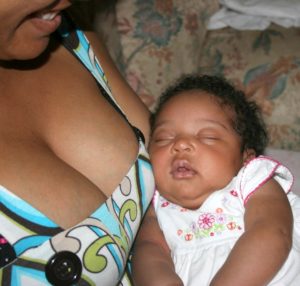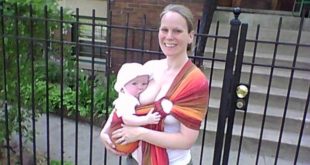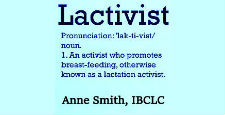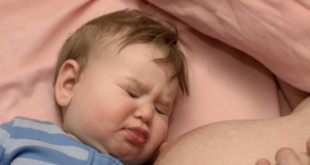
In recent years, formula manufacturers have been aggressively marketing their products as the middle ground where all parents can share, compromise and support each other. Examples of this include Similac’s “Sisterhood of Motherhood” and the “I Support You” campaigns which boldly claim that their objective is to stand behind parents no matter what their feeding choices.
Their premise is that no matter what method a mother uses to feed her baby or what type of milk she feeds her baby, the support is unconditional. Indeed, I have yet to meet a person who would not feed a hungry baby, so in effect they view ‘everyone’ as a potential ally.
While these campaigns accentuate the positive to achieve their goals, the Fed Is Best (FIB) campaign uses fear to inform parents by implying that even when a mother is breastfeeding, she probably needs formula too. While the theme of fear is not evident in the meme, it relies in
part on its fear narrative to reassure and educate its core audience that using formula is being ‘better safe than sorry’, ‘erring on the side of caution’, or adhering to a ‘golden mean’.
The function of this meme is to reinforce the earlier fear stories which FIB circulated by implying that all will turn out right in the end if mothers follow their message.

“Culture is seen as communicated through symbols, each standing ambiguously for a multiplicity of meanings. It is this ambiguity which enables a system of symbols to maintain a façade of order, the perception of rational process”. [1]
The first FIB article focused on the text of the meme above and as promised, this article focuses on the non verbal communication within the meme by looking at the multimodal aspects of the meme such as the colour, layout, framing, highlighting, and context. [2]
‘Symbolic forms and techniques are manipulated by asymmetrical groups in the articulation of basic interests.” [1] and it is this asymmetrical relationship between the FIB organisation and mothers who look toward it for leadership that will be discussed below.
As previously discussed, the cartoon depiction of the scene recalls a period from possibly the 50s to the 80s, a period before social media when life was simpler. A ‘screen grab’ from a familiar domestic scene plays out in the meme. The mother wears her green bathrobe, a green that identifies with the FIB branding. The shadows of window blinds on the wall suggests early morning, maybe after the baby’s father has gone to work. Her hair looks well-groomed and she seems well rested and happy. From this angle, she is sitting on the viewer’s left but still occupying the left side of the scene and facing the morning light. Another reinforcing point is that she is facing east, the direction of the new day and to the future rather than west, the dying of the day and the start of dark nights. These techniques in cinematography denote the protagonist, the heroine. The viewer’s perspective which looks up to her just slightly adds to her sense of control in the scene, a cinematic technique that suggests power [3]. This mother, dressed in and framed by the green FIB logo, is in control, is in power, and is the heroine we look up to. FIB is implying that the organisation and this mother are the same unit.
A mother, feeding her infant twins in the early morning light of her home, twins who seem older than neonates but younger than 6 months. Nothing is unusual except for the non-identical twins which symbolizes a very busy mother. Despite the additional responsibilities of looking after two babies, the mother portrays confidence. Bathed in early morning light, the metaphorical and literal darkness is behind her. So is her shadow behind behind the sofa. Any darkness which may have existed in the neonatal period, from 0 – 30 days, is symbolically behind her.
The mother simultaneously feeds two infants. One baby is breastfed while the other is formula fed. The breast fed baby, dressed in blue, suggests that this is a boy and he is the one that she is looking at. The baby beside her in a car seat on the couch is dressed in pink and being fed with a bottle. One interpretation is that this is a view of equality in infant feeding. She has found that middle ground that facilitates her needs and the needs of her babies. It could be claimed that there is expressed breastmilk in the bottle and that is undoubtedly possible, however it is fair to assume also that the meme intends to suggest that formula is in the bottle. There is also no breast pump nearby which would function as a prop for what is in the bottle but the tin of ‘Healthy Choice Formula’ on the side table seals the intention of what is in the bottle. Ironically, you have to wonder if the FIB organisation intended to suggest that there is ‘unhealthy choice’ formula as this possibility is suggested by the presence of ‘healthy choice’.
While the idealized image above reassures mothers that this is undoubtedly an option and these are revealed with the skills that are typically used in advertising and cinematography to achieve a desired effect in the audience, beneath the advertisers’ polish are some difficult truths to unveil. Truths which undermine basic infant care and infant feeding care. Truths that show that without evidence based information, this meme is propaganda dressed as information.
If we accept that the baby in blue is breastfeeding and that this portrays the cradle hold, then it isn’t a sustainable hold depicted with one arm on the middle of his back. As the baby’s body isn’t really supported then he could arguably be in the ‘laid back’ breastfeeding position except the mother would also be reclined instead of upright.
Breastfeeding requires frequent opportunities to breastfeed, far more often than formula feeding does so this idyllic scene will only occur a few times a day if breastfeeding will be sustained, leaving the formula fed baby with fewer opportunities to be held while the mother focuses on breastfeeding. Or the breastfed baby could be topped up so that he only feeds when the formula fed one is fed. Topping up with formula frequently leads to exclusive formula feeding.
The formula scoop sits atop the tin. There is clear information on formula containers and in leaflets produced by health agencies that the scoop must be stored inside the tin. This is to reduce contamination and concerns about swapping scoops should it be misplaced. Different brands, even different formulations of the same product may have different scoop sizes and swapping could result in over or under concentrated formula.
Manufacturers of car seats, bouncy chairs, and other seating devices provide hazard warnings to never place a child in a seat on top of household furniture, even in the presence of parents [3]. Sadly, accidents involving these devices occasionally turn up in the media as the accidents can result in life changing injury or death. It is also unsafe to have the baby unfastened in the carseat as shown in the meme.
Additionally, a baby fed with a feeding bottle has the same needs to be fed in arms as they deserve the same closeness and attention as a breastfed baby. Best practice bottle feeding is to hold the baby in an upright position with the bottle tilted at about right angle to the baby. A reclined position as is illustrated with the bottle is a choking and aspiration hazard since the baby cannot control the flow of milk as she could in a paced bottle feeding position. Ironically, there is evidence in this meme that the baby is struggling with the flow from the bottle. The baby’s upraised hands and splayed fingers on display is a sign of stress [4] that bottle fed infants show when they are struggling to control the milk flow. As this is a common feature of bottle feeding practice and an indication of lack of awareness of safer bottle feeding, the meme maker has probably inadvertently demonstrated how embedded it has become in our culture to overfeed bottle fed babies.
Bottle feeding requires eye contact, arguably more eye contact than breastfeeding, for positional safety as well as to prevent overfeeding.
“Why does it matter? It is only a friendly meme.” is a counterpoint to the inaccuracies discussed above.
It matters because mothers trust the FIB organisation who hopes that parents will believe them. In using the advertising techniques described above, they deliberately set out to create a brand identity to increase loyalty and gain followers.
It matters because they are reflecting and reinforcing social norms in infant care that are known to be unsafe but may not yet be widely known to parents. They have a duty to use their imagery to reproduce up to date and evidence based information on infant care beyond infant feeding when the organisation uses imagery.
The next article will focus on who is represented in the imagery and who are not and why this is important to the FIB message.
Yolanda Forster is a mother of two who teaches and has an MA in Applied Linguistics with specific interest in language and power.

References:
[1] Rosen, M. (1985). “Breakfast at Spiro’s: Dramaturgy and Dominance”. Journal of Management (2:2 pp 31-48)
[2] MODE (2012). Glossary of multimodal terms. available at: https://multimodalityglossary.wordpress.com/. accessed 25 May 2017
[3] Renee, V. (2016) “Left or right? Why a character’s lateral movement on screen matters in film.” Available at: http://nofilmschool.com/2016/02/left-or-right-why-characters-lateral-movement-screen-matters-film accessed 2 May 2017
[4] Parikh S., Wilson, L. (2010) Hazardous Use of Car Seats Outside the Car in the United States, 2003–2007. Pediatrics. available at: http://pediatrics.aappublications.org/content/early/2010/07/05/peds.2010-0333 accessed 25 May 2017.
[5] Bickford, F. (2010) Baby-led Bottle Feeding. Nurtured Child. Available at: http://nurturedchild.ca/index.php/2010/12/10/baby-led-bottle-feeding/accessed 25 May 2017
 Breastfeeding Basics
Breastfeeding Basics




This makes many, many good points. I wanted to also point out that the baby in the car seat is in an extremely unsafe position – car seats are not supposed to be used on soft surfaces, babies aren’t supposed to sleep in them outside the car, and they are always supposed to be strapped in when they are in them. FIB pretends to be about “safety,” yet they are depicting a very unsafe situation in one of their memes! We know they aren’t really about safety, anyway, but this is just one point where it’s blatantly obvious that safety is not really their concern.